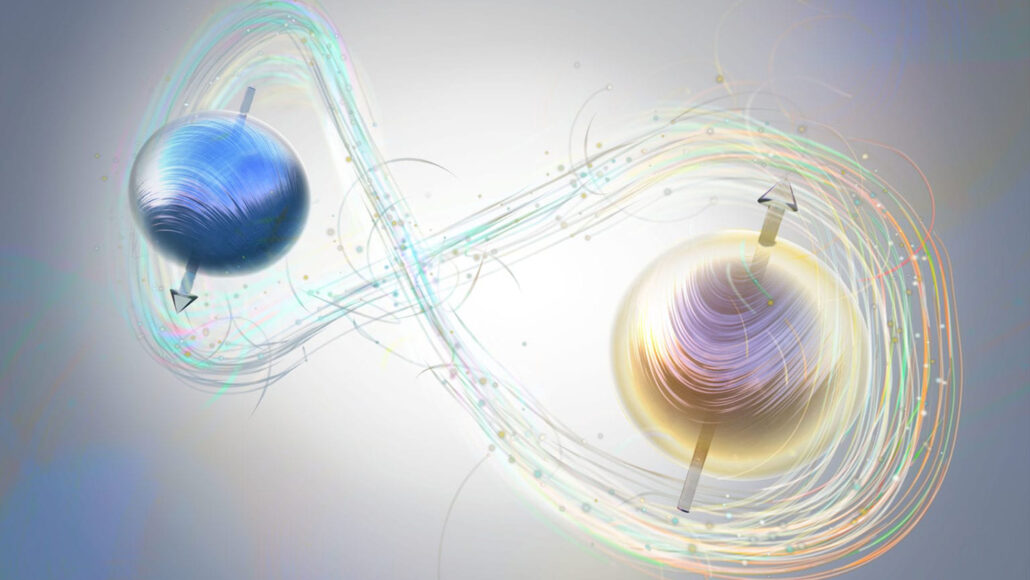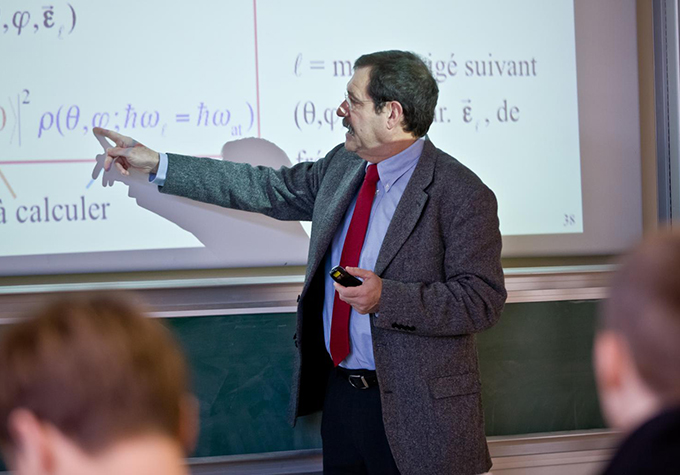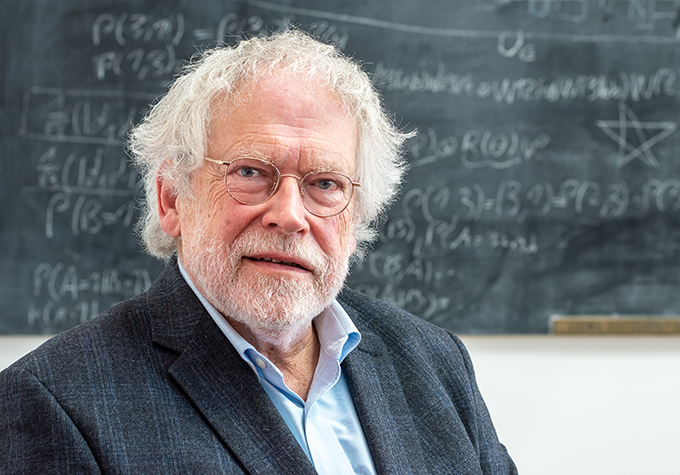Experiments on ‘entangled’ quantum particles won the physics Nobel Prize
Physicists Alain Aspect, John Clauser and Anton Zeilinger share the award

Experiments on entanglement — a strange feature of quantum physics — have netted three scientists the 2022 Nobel Prize in physics. When two particles are entangled (illustrated), what happens to one determines what happens to the other — even when the second one is far away.
Nicolle R. Fuller/NSF
By James R. Riordon and Maria Temming
For their tests of quantum weirdness and its real-world uses, three scientists will share the 2022 Nobel Prize in physics.
Quantum physics is the science of super small things. It governs how atoms and even tinier particles behave. Such itty-bitty bits of matter don’t obey the same rules as larger objects. One especially strange feature of quantum physics is “entanglement.” When two particles are entangled, everything about them — from their speed to the way they spin — is perfectly connected. If you know the state of one particle, then you know the state of the other. This is true even when the linked particles are very far apart.
When this idea was first proposed, physicists like Albert Einstein were skeptical. Math might allow entanglement in theory, they thought. But there should be no way such linked particles could exist in the real world.
This year’s Nobel Prize winners show that, in fact, it does. And it could lead to many new technologies. Completely secure systems of communication, for instance. Or quantum computers that solve problems that stump any ordinary computer.
Each of this year’s winners will take home a third of the prize money, which totals 10 million Swedish kronor (worth roughly $900,000).
One winner is Alain Aspect. He works at the Université Paris-Saclay and École Polytechnique in France. Another is John Clauser, who runs a company in California. These two confirmed that the rules of quantum physics really do rule the world.
Anton Zeilinger, the third winner, works at the University of Vienna in Austria. He has taken advantage of the quantum strangeness confirmed by Aspect and Clauser to develop new technologies.
“Today, we honor three physicists whose pioneering experiments showed us that the strange world of entanglement … is not just the micro-world of atoms, and certainly not the virtual world of science fiction or mysticism,” said Thors Hans Hansson. “It’s the real world that we all live in.” Hansson is a member of the Nobel Committee for Physics, which chose the winners. He spoke at an October 4 press conference at the Royal Swedish Academy of Sciences in Stockholm. It’s where the award was announced.
“It was certainly very exciting to learn about the three laureates,” says Jerry Chow. He’s a physicist at IBM Quantum in Yorktown Heights, N.Y. “They’re all very, very well known in our quantum community. And their work is something that’s really been a big part of many people’s research efforts over many years.”
Proving entanglement
The discovery that quantum rules govern tiny things like atoms and electrons shook up early 20th century physics. Many leading scientists, such as Einstein, thought the math of quantum physics worked in theory. But they weren’t sure it could truly describe the real world. Ideas like entanglement were just too weird. How could you really know the state of one particle by looking at another?
Einstein suspected the quantum weirdness of entanglement was an illusion. There must be some classical physics that could explain how it worked — like the secret to a magic trick. Lab tests, he suspected, were just too crude to uncover that hidden information.

Other scientists believed there was no secret to entanglement. Quantum particles had no hidden back channels for sending information. Some particles could just become perfectly linked, and that was that. It was the way the world worked.
In the 1960s, physicist John Bell came up with a test to prove there was no hidden communication between quantum objects. Clauser was the first one to develop an experiment to run this test. His results supported Bell’s idea about entanglement. Linked particles just are.
But Clauser’s test had some loopholes. These left room for doubt. Aspect ran another test that ruled out any chance quantum strangeness could be cleared up by some hidden explanation.
Clauser and Aspect’s experiments involved pairs of light particles, or photons. They created pairs of entangled photons. This meant the particles acted like a single object. As the photons moved apart, they stayed entangled. That is, they kept acting as a single, extended object. Measuring the features of one instantly revealed those of the other. This was true no matter how far apart the photons got.

Entanglement is fragile and hard to maintain. But Clauser and Aspect’s work showed that quantum effects could not be explained by classical physics.
Zeilinger’s experiments show the practical uses of these effects. For instance, he has used entanglement to create absolutely secure encryption and communication. Here’s how it works: Interacting with one entangled particle affects another. So, anyone trying to peek at secret quantum information would break the particles’ entanglement as soon as they snooped. That means nobody can spy on a quantum message without getting caught.
Zeilinger has also pioneered another use for entanglement. That is quantum teleportation. This isn’t like people popping from one place to another in science fiction and fantasy. The effect involves sending information from one place to another about a quantum object.
Quantum computers are another technology that would rely on entangled particles. Normal computers process data using ones and zeroes. Quantum computers would use bits of information that are each a blend of one and zero. In theory, such machines could run calculations that no normal computer can.
Quantum boom

“This [award] is a very nice and positive surprise to me,” says Nicolas Gisin. He’s a physicist at the University of Geneva in Switzerland. “This prize is very well-deserved. But comes a bit late. Most of that work was done in the [1970s and 1980s]. But the Nobel Committee was very slow and now is rushing after the boom of quantum technologies.”
That boom is happening around the world, Gisin says. “Instead of having a few individuals pioneering the field, now we have really huge crowds of physicists and engineers that work together.”
Some of the most cutting-edge uses of quantum physics are still in their infancy. But the three new Nobel laureates have helped transform this strange science from an abstract curiosity into something useful. Their work validates some key, once-contested ideas of modern physics. Someday, it may also become a basic part of our daily lives, in ways not even Einstein could deny.







